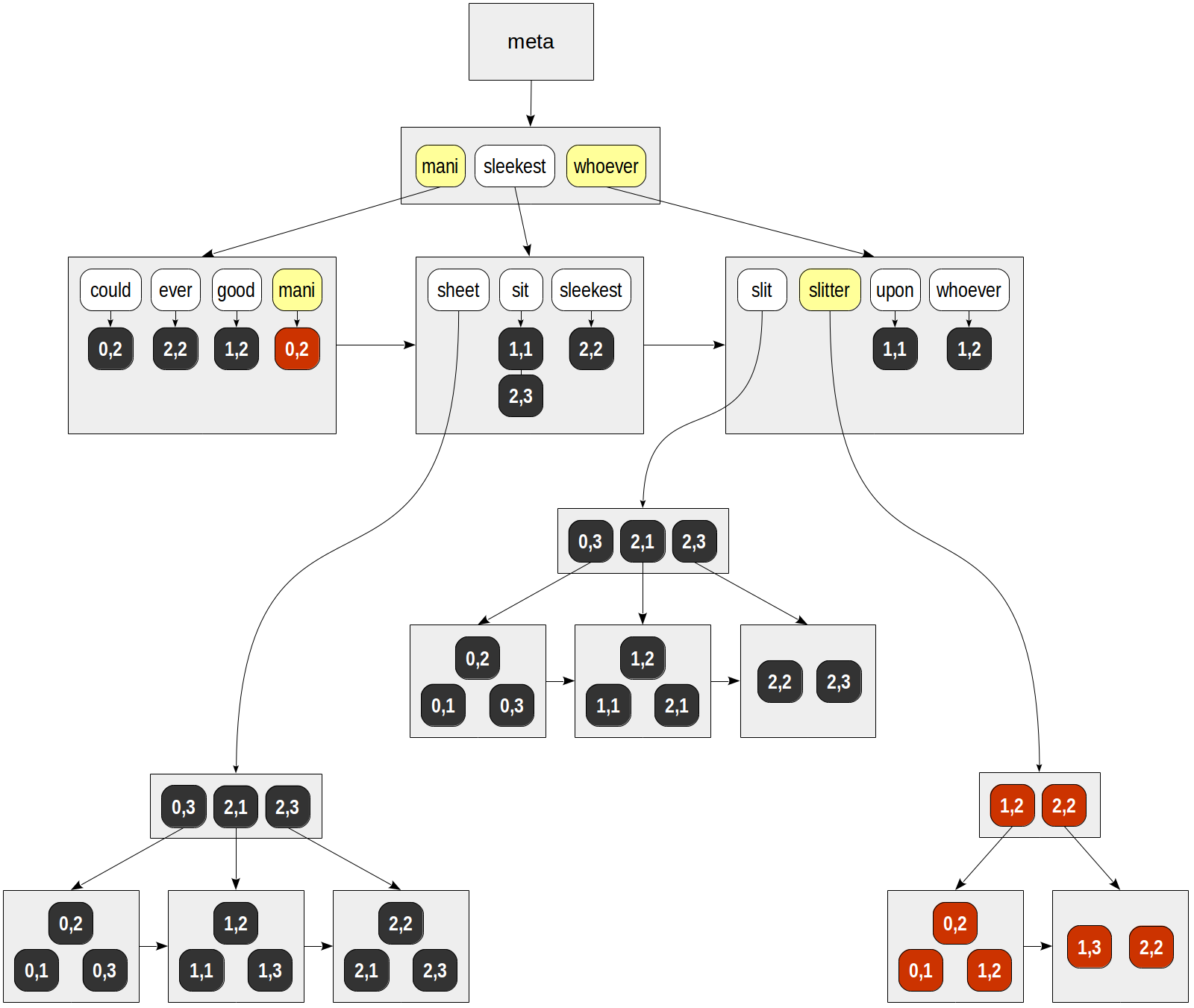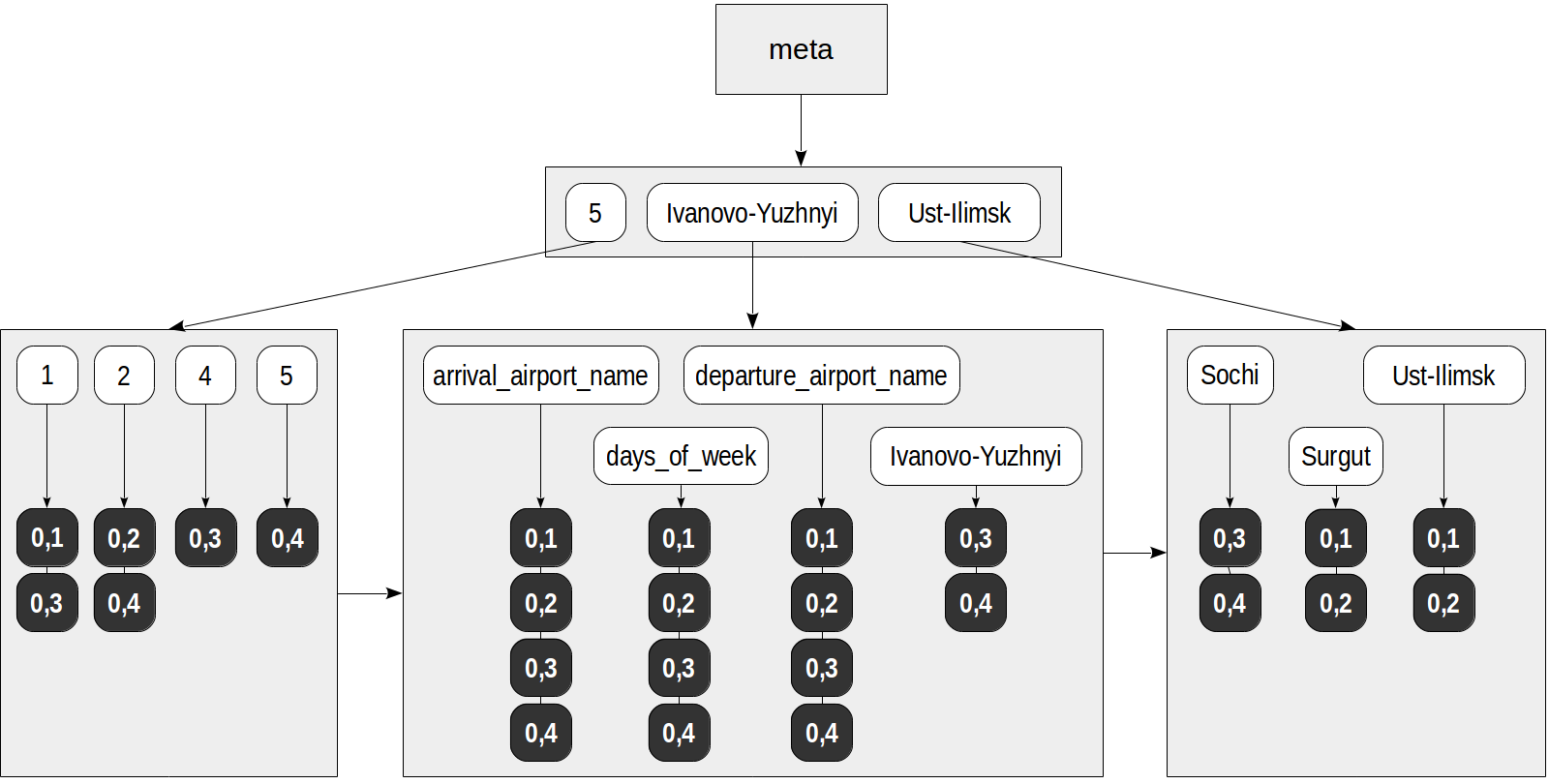我们已经熟悉PostgreSQL
索引引擎和访问方法的界面,并讨论了
哈希索引 ,
B树 ,
GiST和
SP-GiST索引。 并且本文将介绍GIN索引。
杜松子酒
“杜松子酒。。杜松子酒似乎是一种美国酒?。”
“我不是喝酒,哦,好奇的男孩!” 老人又爆发了出来,又一次意识到了自己,并再次将自己握在手中。 “我不是喝酒,而是一种强大而勇敢的精神,世界上没有我无法做到的魔力。”-拉扎尔·拉金(Lazar Lagin),《老霍塔比奇》。
杜松子酒(Gin)代表广义倒置索引,应被视为精灵,而非酒水。-
自述文件一般概念
GIN是缩写的广义倒排索引。 这就是所谓的
倒排索引 。 它处理其值不是原子的而是由元素组成的数据类型。 我们将这些类型称为复合。 这些不是索引的值,而是各个元素。 每个元素都引用其出现的值。
这种方法的一个很好的类比是书末的索引,该索引为每个术语提供了该术语出现的页面列表。 访问方法必须确保快速搜索索引元素,就像书中的索引一样。 因此,这些元素存储为熟悉的
B树 (为其使用了不同的,更简单的实现,但是在这种情况下无关紧要)。 对包含元素的复合值的表行的有序引用集链接到每个元素。 有序性对于数据检索至关重要(TID的排序顺序并不重要),但对索引的内部结构很重要。
元素永远不会从GIN索引中删除。 可以认为包含元素的值可以消失,出现或变化,但是组成它们的元素集或多或少是稳定的。 该解决方案极大地简化了带有索引的多个进程的并发工作的算法。
如果TID列表很小,则可以与该元素放入同一页面(称为“发布列表”)。 但是,如果列表很大,则需要一种更有效的数据结构,并且我们已经意识到了-它又是B树。 这样的树位于单独的数据页上(称为“发布树”)。
因此,GIN索引由元素的B树组成,并且B树或TID的平面列表链接到该B树的叶行。
就像前面讨论的GiST和SP-GiST索引一样,GIN为应用程序开发人员提供了界面,以支持对复合数据类型的各种操作。
全文搜索
GIN方法的主要应用领域是加速全文搜索,因此,在对该索引进行更详细的讨论时,可以将其用作示例。
与GiST相关的文章已经提供了全文搜索的
简短介绍,因此让我们直接讲一点。 很明显,这种情况下的复合值是
文档 ,而这些文档的元素是
词素 。
让我们考虑与GiST相关的文章中的示例:
postgres=# create table ts(doc text, doc_tsv tsvector); postgres=# insert into ts(doc) values ('Can a sheet slitter slit sheets?'), ('How many sheets could a sheet slitter slit?'), ('I slit a sheet, a sheet I slit.'), ('Upon a slitted sheet I sit.'), ('Whoever slit the sheets is a good sheet slitter.'), ('I am a sheet slitter.'), ('I slit sheets.'), ('I am the sleekest sheet slitter that ever slit sheets.'), ('She slits the sheet she sits on.'); postgres=# update ts set doc_tsv = to_tsvector(doc); postgres=# create index on ts using gin(doc_tsv);
该索引的可能结构如图所示:

与前面的所有图中的图不同,对表行(TID)的引用在深色背景(页面编号和页面位置)上用数字表示,而不用箭头表示。
postgres=# select ctid, left(doc,20), doc_tsv from ts;
ctid | left | doc_tsv -------+----------------------+--------------------------------------------------------- (0,1) | Can a sheet slitter | 'sheet':3,6 'slit':5 'slitter':4 (0,2) | How many sheets coul | 'could':4 'mani':2 'sheet':3,6 'slit':8 'slitter':7 (0,3) | I slit a sheet, a sh | 'sheet':4,6 'slit':2,8 (1,1) | Upon a slitted sheet | 'sheet':4 'sit':6 'slit':3 'upon':1 (1,2) | Whoever slit the she | 'good':7 'sheet':4,8 'slit':2 'slitter':9 'whoever':1 (1,3) | I am a sheet slitter | 'sheet':4 'slitter':5 (2,1) | I slit sheets. | 'sheet':3 'slit':2 (2,2) | I am the sleekest sh | 'ever':8 'sheet':5,10 'sleekest':4 'slit':9 'slitter':6 (2,3) | She slits the sheet | 'sheet':4 'sit':6 'slit':2 (9 rows)
在此推测性示例中,TID列表适合所有词素(“工作表”,“狭缝”和“分切器”)的常规页面。 这些词素出现在许多文档中,并且它们的TID列表已放入单独的B树中。
顺便说一句,我们如何找出包含一个词素的文档? 对于一张小桌子,下面显示的一种“直接”技术将起作用,但是我们将进一步学习如何处理较大的桌子。
postgres=# select (unnest(doc_tsv)).lexeme, count(*) from ts group by 1 order by 2 desc;
lexeme | count ----------+------- sheet | 9 slit | 8 slitter | 5 sit | 2 upon | 1 mani | 1 whoever | 1 sleekest | 1 good | 1 could | 1 ever | 1 (11 rows)
还要注意,与常规B树不同,GIN索引的页面是通过单向列表而不是双向列表连接的。 这是足够的,因为仅以一种方式完成树遍历。
查询示例
对于我们的示例,将如何执行以下查询?
postgres=# explain(costs off) select doc from ts where doc_tsv @@ to_tsquery('many & slitter');
QUERY PLAN --------------------------------------------------------------------- Bitmap Heap Scan on ts Recheck Cond: (doc_tsv @@ to_tsquery('many & slitter'::text)) -> Bitmap Index Scan on ts_doc_tsv_idx Index Cond: (doc_tsv @@ to_tsquery('many & slitter'::text)) (4 rows)
首先从查询中提取单个词素(搜索关键字):“ mani”和“ slitter”。 这是由专门的API函数完成的,该函数考虑了操作员类确定的数据类型和策略:
postgres=# select amop.amopopr::regoperator, amop.amopstrategy from pg_opclass opc, pg_opfamily opf, pg_am am, pg_amop amop where opc.opcname = 'tsvector_ops' and opf.oid = opc.opcfamily and am.oid = opf.opfmethod and amop.amopfamily = opc.opcfamily and am.amname = 'gin' and amop.amoplefttype = opc.opcintype;
amopopr | amopstrategy -----------------------+-------------- @@(tsvector,tsquery) | 1 matching search query @@@(tsvector,tsquery) | 2 synonym for @@ (for backward compatibility) (2 rows)
接下来,在词素的B树中,找到这两个键,并仔细查看TID的列表。 我们得到:
为“ mani”-(0,2)。
对于“分片”-(0,1),(0,2),(1,2),(1,3),(2,2)。

最后,对于找到的每个TID,将调用API一致性函数,该函数必须确定找到的哪些行与搜索查询匹配。 由于查询中的词素由布尔“和”连接,因此返回的唯一行是(0,2):
| | | consistency | | | function TID | mani | slitter | slit & slitter -------+------+---------+---------------- (0,1) | f | T | f (0,2) | T | T | T (1,2) | f | T | f (1,3) | f | T | f (2,2) | f | T | f
结果是:
postgres=# select doc from ts where doc_tsv @@ to_tsquery('many & slitter');
doc --------------------------------------------- How many sheets could a sheet slitter slit? (1 row)
如果将这种方法与已经针对GiST讨论的方法进行比较,则GIN在全文搜索中的优势显而易见。 但这不只是令人眼前一亮。
更新缓慢的问题
事实是,GIN索引中的数据插入或更新非常慢。 每个文档通常包含许多要索引的词素。 因此,当仅添加或更新一个文档时,我们必须大量更新索引树。
另一方面,如果同时更新几个文档,则它们的某些词素可能相同,并且总工作量将小于一次一个地更新文档时的工作量。
GIN索引具有“ fastupdate”存储参数,我们可以在创建索引时指定它,并在以后更新:
postgres=# create index on ts using gin(doc_tsv) with (fastupdate = true);
启用此参数后,更新将累积在单独的无序列表中(在各个连接的页面上)。 当此列表足够大时或在清理期间,所有累积的更新将立即对索引进行。 哪些列表被认为“足够大”由配置参数“ gin_pending_list_limit”或索引的同名存储参数确定。
但是这种方法有缺点:首先,搜索速度变慢(因为除了树之外还需要浏览无序列表),其次,如果无序列表已溢出,则下一次更新可能会意外地花费大量时间。
搜索部分匹配
我们可以在全文搜索中使用部分匹配。 例如,考虑以下查询:
gin=# select doc from ts where doc_tsv @@ to_tsquery('slit:*');
doc -------------------------------------------------------- Can a sheet slitter slit sheets? How many sheets could a sheet slitter slit? I slit a sheet, a sheet I slit. Upon a slitted sheet I sit. Whoever slit the sheets is a good sheet slitter. I am a sheet slitter. I slit sheets. I am the sleekest sheet slitter that ever slit sheets. She slits the sheet she sits on. (9 rows)
该查询将查找包含以“ slit”开头的词素的文档。 在此示例中,这样的词素是“狭缝”和“分切”。
即使没有索引,查询当然也可以工作,但是GIN还可以加快以下搜索的速度:
postgres=# explain (costs off) select doc from ts where doc_tsv @@ to_tsquery('slit:*');
QUERY PLAN ------------------------------------------------------------- Bitmap Heap Scan on ts Recheck Cond: (doc_tsv @@ to_tsquery('slit:*'::text)) -> Bitmap Index Scan on ts_doc_tsv_idx Index Cond: (doc_tsv @@ to_tsquery('slit:*'::text)) (4 rows)
在这里,在树中查找所有在搜索查询中指定了前缀的词素,并用布尔“或”将其连接起来。
频繁和不频繁的口语
为了观察索引如何处理实时数据,让我们看一下“ pgsql-hackers”电子邮件的存档,在讨论GiST时我们已经使用了它。
此版本的存档包含356125条消息,其中包含发送日期,主题,作者和文本。
fts=# alter table mail_messages add column tsv tsvector; fts=# update mail_messages set tsv = to_tsvector(body_plain);
NOTICE: word is too long to be indexed DETAIL: Words longer than 2047 characters are ignored. ... UPDATE 356125
fts=# create index on mail_messages using gin(tsv);
让我们考虑一下出现在许多文档中的词素。 使用“ unnest”的查询将无法处理如此大的数据量,正确的技术是使用“ ts_stat”功能,该功能提供有关词素,出现它们的文档数以及出现总数的信息。
fts=# select word, ndoc from ts_stat('select tsv from mail_messages') order by ndoc desc limit 3;
word | ndoc -------+-------- re | 322141 wrote | 231174 use | 176917 (3 rows)
让我们选择“写”。
而且,我们会用一些不常见的单词作为开发人员的电子邮件,例如“纹身”:
fts=# select word, ndoc from ts_stat('select tsv from mail_messages') where word = 'tattoo';
word | ndoc --------+------ tattoo | 2 (1 row)
这两个词素都出现了吗? 看来有:
fts=# select count(*) from mail_messages where tsv @@ to_tsquery('wrote & tattoo');
count ------- 1 (1 row)
出现一个问题,如何执行此查询。 如上所述,如果我们获得两个词素的TID列表,则搜索显然效率低下:我们将必须遍历20万多个值,只剩下其中一个。 幸运的是,使用计划程序统计信息,该算法可以了解到“写”词位经常出现,而“ tatoo”则很少出现。 因此,执行不经常使用的词素的搜索,然后检查检索到的两个文档中是否存在“写”词素。 从查询中可以很容易地看出这一点,它可以快速执行:
fts=# \timing on fts=# select count(*) from mail_messages where tsv @@ to_tsquery('wrote & tattoo');
count ------- 1 (1 row) Time: 0,959 ms
仅搜索“ wrote”要花费更长的时间:
fts=# select count(*) from mail_messages where tsv @@ to_tsquery('wrote');
count -------- 231174 (1 row) Time: 2875,543 ms (00:02,876)
当然,这种优化不仅适用于两个词素,而且在更复杂的情况下也适用。
限制查询结果
GIN访问方法的一个特点是,结果总是以位图的形式返回:该方法不能按TID返回结果TID。 因此,本文中的所有查询计划都使用位图扫描。
因此,使用LIMIT子句限制索引扫描结果的效率不是很高。 注意操作的预计成本(“限制”节点的“成本”字段):
fts=# explain (costs off) select * from mail_messages where tsv @@ to_tsquery('wrote') limit 1;
QUERY PLAN ----------------------------------------------------------------------------------------- Limit (cost=1283.61..1285.13 rows=1) -> Bitmap Heap Scan on mail_messages (cost=1283.61..209975.49 rows=137207) Recheck Cond: (tsv @@ to_tsquery('wrote'::text)) -> Bitmap Index Scan on mail_messages_tsv_idx (cost=0.00..1249.30 rows=137207) Index Cond: (tsv @@ to_tsquery('wrote'::text)) (5 rows)
估计成本为1285.13,这比构建整个位图1249.30(位图索引扫描节点的“成本”字段)的成本要大一些。
因此,索引具有限制结果数量的特殊功能。 阈值在“ gin_fuzzy_search_limit”配置参数中指定,并且默认情况下等于零(没有限制)。 但是我们可以设置阈值:
fts=# set gin_fuzzy_search_limit = 1000; fts=# select count(*) from mail_messages where tsv @@ to_tsquery('wrote');
count ------- 5746 (1 row)
fts=# set gin_fuzzy_search_limit = 10000; fts=# select count(*) from mail_messages where tsv @@ to_tsquery('wrote');
count ------- 14726 (1 row)
如我们所见,对于不同的参数值(如果使用索引访问),查询返回的行数会有所不同。 限制并不严格:可以返回多于指定行的行,这证明参数名称的“模糊”部分是合理的。
紧凑的表示
在其他方面,由于其紧凑性,GIN索引很好。 首先,如果在多个文档中出现相同的词素(通常是这种情况),则它仅在索引中存储一次。 其次,TID以有序的方式存储在索引中,这使我们能够使用一种简单的压缩方式:列表中的每个下一个TID实际上都存储为与上一个TID的不同; 这通常是一个很小的数字,与完整的六字节TID相比,所需的位数要少得多。
为了了解其大小,让我们从消息文本构建B树。 但是,肯定不会发生公平的比较:
- GIN建立在其他较小的数据类型(“ tsvector”而非“ text”)上,
- 同时,B树的消息大小必须缩短到大约2 KB。
尽管如此,我们继续:
fts=# create index mail_messages_btree on mail_messages(substring(body_plain for 2048));
我们还将建立GiST索引:
fts=# create index mail_messages_gist on mail_messages using gist(tsv);
“真空已满”时的索引大小:
fts=# select pg_size_pretty(pg_relation_size('mail_messages_tsv_idx')) as gin, pg_size_pretty(pg_relation_size('mail_messages_gist')) as gist, pg_size_pretty(pg_relation_size('mail_messages_btree')) as btree;
gin | gist | btree --------+--------+-------- 179 MB | 125 MB | 546 MB (1 row)
由于表示的紧凑性,我们可以尝试在从Oracle迁移过程中使用GIN索引来代替位图索引(在此不做详细介绍,出于好奇心,我为
Lewis的文章提供
了参考 )。 通常,位图索引用于唯一值很少的字段,这对于GIN也非常有用。 而且,如
第一篇文章所示,PostgreSQL可以基于任何索引(包括GIN)动态构建位图。
是GiST还是GIN?
对于许多数据类型,GiST和GIN都可以使用运算符类,这引起了使用哪个索引的问题。 也许,我们已经可以得出一些结论。
通常,GIN在准确性和搜索速度上均胜过GiST。 如果数据更新不频繁并且需要快速搜索,则很可能会选择GIN。
另一方面,如果对数据进行密集更新,则更新GIN的开销成本可能看起来太大。 在这种情况下,我们将不得不比较这两种选择,并选择其特征更好地平衡的选择。
数组
使用GIN的另一个示例是数组的索引。 在这种情况下,数组元素进入索引,这可以加快对数组的大量操作:
postgres=# select amop.amopopr::regoperator, amop.amopstrategy from pg_opclass opc, pg_opfamily opf, pg_am am, pg_amop amop where opc.opcname = 'array_ops' and opf.oid = opc.opcfamily and am.oid = opf.opfmethod and amop.amopfamily = opc.opcfamily and am.amname = 'gin' and amop.amoplefttype = opc.opcintype;
amopopr | amopstrategy -----------------------+-------------- &&(anyarray,anyarray) | 1 intersection @>(anyarray,anyarray) | 2 contains array <@(anyarray,anyarray) | 3 contained in array =(anyarray,anyarray) | 4 equality (4 rows)
我们的
演示数据库具有“路线”视图以及航班信息。 在其余视图中,此视图包含“ days_of_week”列-发生航班的工作日数组。 例如,从伏努科沃飞往格连吉克的航班在星期二,星期四和星期日出发:
demo=# select departure_airport_name, arrival_airport_name, days_of_week from routes where flight_no = 'PG0049';
departure_airport_name | arrival_airport_name | days_of_week ------------------------+----------------------+-------------- Vnukovo | Gelendzhik | {2,4,7} (1 row)
为了建立索引,让我们将视图“物化”到表中:
demo=# create table routes_t as select * from routes; demo=# create index on routes_t using gin(days_of_week);
现在,我们可以使用该索引来了解在星期二,星期四和星期日出发的所有航班:
demo=# explain (costs off) select * from routes_t where days_of_week = ARRAY[2,4,7];
QUERY PLAN ----------------------------------------------------------- Bitmap Heap Scan on routes_t Recheck Cond: (days_of_week = '{2,4,7}'::integer[]) -> Bitmap Index Scan on routes_t_days_of_week_idx Index Cond: (days_of_week = '{2,4,7}'::integer[]) (4 rows)
看来其中有六个:
demo=# select flight_no, departure_airport_name, arrival_airport_name, days_of_week from routes_t where days_of_week = ARRAY[2,4,7];
flight_no | departure_airport_name | arrival_airport_name | days_of_week -----------+------------------------+----------------------+-------------- PG0005 | Domodedovo | Pskov | {2,4,7} PG0049 | Vnukovo | Gelendzhik | {2,4,7} PG0113 | Naryan-Mar | Domodedovo | {2,4,7} PG0249 | Domodedovo | Gelendzhik | {2,4,7} PG0449 | Stavropol | Vnukovo | {2,4,7} PG0540 | Barnaul | Vnukovo | {2,4,7} (6 rows)
该查询如何执行? 与上述方法完全相同:
- 从此处起搜索查询作用的数组{2,4,7}中提取元素(搜索关键字)。 显然,这些是“ 2”,“ 4”和“ 7”的值。
- 在元素树中,找到提取的键,并为每个键选择TID列表。
- 在找到的所有TID中,一致性功能会从查询中选择与运算符匹配的TID。 对于
=运算符,只有那些TID匹配出现在所有三个列表中的TID(换句话说,初始数组必须包含所有元素)。 但这还不够:数组还需要不包含任何其他值,并且我们无法使用索引检查此条件。 因此,在这种情况下,访问方法要求索引引擎重新检查与表一起返回的所有TID。
有趣的是,有些策略(例如“包含在数组中”)无法检查任何内容,而必须重新检查在表中找到的所有TID。
但是,如果我们需要知道周二,周四和周日从莫斯科出发的航班怎么办? 索引不支持其他条件,该条件将进入“过滤器”列。
demo=# explain (costs off) select * from routes_t where days_of_week = ARRAY[2,4,7] and departure_city = 'Moscow';
QUERY PLAN ----------------------------------------------------------- Bitmap Heap Scan on routes_t Recheck Cond: (days_of_week = '{2,4,7}'::integer[]) Filter: (departure_city = 'Moscow'::text) -> Bitmap Index Scan on routes_t_days_of_week_idx Index Cond: (days_of_week = '{2,4,7}'::integer[]) (5 rows)
此处可以(索引仅选择六行),但是在附加条件增加了选择能力的情况下,希望有这样的支持。 但是,我们不能只创建索引:
demo=# create index on routes_t using gin(days_of_week,departure_city);
ERROR: data type text has no default operator class for access method "gin" HINT: You must specify an operator class for the index or define a default operator class for the data type.
但是“
btree_gin ”扩展名会有所帮助,它添加了GIN运算符类来模拟常规B树的工作。
demo=# create extension btree_gin; demo=# create index on routes_t using gin(days_of_week,departure_city); demo=# explain (costs off) select * from routes_t where days_of_week = ARRAY[2,4,7] and departure_city = 'Moscow';
QUERY PLAN --------------------------------------------------------------------- Bitmap Heap Scan on routes_t Recheck Cond: ((days_of_week = '{2,4,7}'::integer[]) AND (departure_city = 'Moscow'::text)) -> Bitmap Index Scan on routes_t_days_of_week_departure_city_idx Index Cond: ((days_of_week = '{2,4,7}'::integer[]) AND (departure_city = 'Moscow'::text)) (4 rows)
杰森
具有内置GIN支持的复合数据类型的另一个示例是JSON。 为了使用JSON值,目前定义了许多运算符和函数,其中一些可以使用索引加快:
postgres=# select opc.opcname, amop.amopopr::regoperator, amop.amopstrategy as str from pg_opclass opc, pg_opfamily opf, pg_am am, pg_amop amop where opc.opcname in ('jsonb_ops','jsonb_path_ops') and opf.oid = opc.opcfamily and am.oid = opf.opfmethod and amop.amopfamily = opc.opcfamily and am.amname = 'gin' and amop.amoplefttype = opc.opcintype;
opcname | amopopr | str ----------------+------------------+----- jsonb_ops | ?(jsonb,text) | 9 top-level key exists jsonb_ops | ?|(jsonb,text[]) | 10 some top-level key exists jsonb_ops | ?&(jsonb,text[]) | 11 all top-level keys exist jsonb_ops | @>(jsonb,jsonb) | 7 JSON value is at top level jsonb_path_ops | @>(jsonb,jsonb) | 7 (5 rows)
如我们所见,有两个操作符类可用:“ jsonb_ops”和“ jsonb_path_ops”。
默认情况下,使用第一个运算符类“ jsonb_ops”。 所有键,值和数组元素都将作为初始JSON文档的元素到达索引。 将属性添加到这些元素中的每个元素,以指示该元素是否为键(“存在”策略需要此属性,以区分键和值)。
例如,让我们将“ routes”中的几行表示为JSON,如下所示:
demo=# create table routes_jsonb as select to_jsonb(t) route from ( select departure_airport_name, arrival_airport_name, days_of_week from routes order by flight_no limit 4 ) t; demo=# select ctid, jsonb_pretty(route) from routes_jsonb;
ctid | jsonb_pretty -------+------------------------------------------------- (0,1) | { + | "days_of_week": [ + | 1 + | ], + | "arrival_airport_name": "Surgut", + | "departure_airport_name": "Ust-Ilimsk" + | } (0,2) | { + | "days_of_week": [ + | 2 + | ], + | "arrival_airport_name": "Ust-Ilimsk", + | "departure_airport_name": "Surgut" + | } (0,3) | { + | "days_of_week": [ + | 1, + | 4 + | ], + | "arrival_airport_name": "Sochi", + | "departure_airport_name": "Ivanovo-Yuzhnyi"+ | } (0,4) | { + | "days_of_week": [ + | 2, + | 5 + | ], + | "arrival_airport_name": "Ivanovo-Yuzhnyi", + | "departure_airport_name": "Sochi" + | } (4 rows)
demo=# create index on routes_jsonb using gin(route);
该索引可能如下所示:

现在,例如,可以使用索引执行如下查询:
demo=# explain (costs off) select jsonb_pretty(route) from routes_jsonb where route @> '{"days_of_week": [5]}';
QUERY PLAN --------------------------------------------------------------- Bitmap Heap Scan on routes_jsonb Recheck Cond: (route @> '{"days_of_week": [5]}'::jsonb) -> Bitmap Index Scan on routes_jsonb_route_idx Index Cond: (route @> '{"days_of_week": [5]}'::jsonb) (4 rows)
从JSON文档的根开始,
@>运算符检查是否发生了指定的路由(
"days_of_week": [5] )。 这里的查询将返回一行:
demo=# select jsonb_pretty(route) from routes_jsonb where route @> '{"days_of_week": [5]}';
jsonb_pretty ------------------------------------------------ { + "days_of_week": [ + 2, + 5 + ], + "arrival_airport_name": "Ivanovo-Yuzhnyi",+ "departure_airport_name": "Sochi" + } (1 row)
查询执行如下:
- 在搜索查询(
"days_of_week": [5] )中,提取元素(搜索关键字):“ days_of_week”和“ 5”。
- 在元素树中找到提取的键,并为每个键选择TID列表:对于“ 5”-(0.4),对于“ days_of_week”-(0,1),(0,2 ),(0.3),(0.4)。
- 在找到的所有TID中,一致性功能会从查询中选择与运算符匹配的TID。 对于
@>运算符,肯定不能包含不包含搜索查询中所有元素的文档,因此仅保留(0,4)。 但是,我们仍然需要重新检查表左侧的TID,因为从索引中不清楚所找到的元素在JSON文档中的出现顺序。
要发现其他操作员的更多详细信息,可以阅读
文档 。
除了用于处理JSON的常规操作外,“ jsquery”扩展名早已可用,该扩展名定义了一种具有更丰富功能的查询语言(当然,还支持GIN索引)。 此外,2016年发布了新的SQL标准,该标准定义了自己的操作集和查询语言“ SQL / JSON路径”。 该标准的实现已经完成,我们相信它将出现在PostgreSQL 11中。
SQL / JSON路径修补程序最终提交给PostgreSQL 12,而其他修补程序仍在进行中。 希望我们能在PostgreSQL 13中看到完全实现的功能。
内部构造
我们可以使用“
pageinspect ”扩展名查看GIN索引。
fts=# create extension pageinspect;
meta页面中的信息显示了常规统计信息:
fts=# select * from gin_metapage_info(get_raw_page('mail_messages_tsv_idx',0));
-[ RECORD 1 ]----+----------- pending_head | 4294967295 pending_tail | 4294967295 tail_free_size | 0 n_pending_pages | 0 n_pending_tuples | 0 n_total_pages | 22968 n_entry_pages | 13751 n_data_pages | 9216 n_entries | 1423598 version | 2
页面结构提供了一个特殊的区域,访问方法可以在其中存储其信息。 对于真空等普通程序,该区域是“不透明的”。 “ Gin_page_opaque_info”函数显示GIN的此数据。 例如,我们可以了解索引页面集:
fts=# select flags, count(*) from generate_series(1,22967) as g(id),
flags | count ------------------------+------- {meta} | 1 meta page {} | 133 internal page of element B-tree {leaf} | 13618 leaf page of element B-tree {data} | 1497 internal page of TID B-tree {data,leaf,compressed} | 7719 leaf page of TID B-tree (5 rows)
“ Gin_leafpage_items”功能提供有关存储在页面{数据,叶子,压缩的}上的TID的信息:
fts=# select * from gin_leafpage_items(get_raw_page('mail_messages_tsv_idx',2672));
-[ RECORD 1 ]--------------------------------------------------------------------- first_tid | (239,44) nbytes | 248 tids | {"(239,44)","(239,47)","(239,48)","(239,50)","(239,52)","(240,3)",... -[ RECORD 2 ]--------------------------------------------------------------------- first_tid | (247,40) nbytes | 248 tids | {"(247,40)","(247,41)","(247,44)","(247,45)","(247,46)","(248,2)",... ...
请注意,TID树的离开页面实际上包含指向表行的小型压缩指针列表,而不是单个指针。
物产
让我们看一下GIN访问方法的属性(
已经提供了查询)。
amname | name | pg_indexam_has_property --------+---------------+------------------------- gin | can_order | f gin | can_unique | f gin | can_multi_col | t gin | can_exclude | f
有趣的是,GIN支持创建多列索引。 但是,与常规B树不同,多列索引仍将存储单个元素,而不是复合键,并且将为每个元素指示列号。
以下索引层属性可用:
name | pg_index_has_property ---------------+----------------------- clusterable | f index_scan | f bitmap_scan | t backward_scan | f
请注意,不支持按TID(索引扫描)返回结果TID。 只能进行位图扫描。
也不支持向后扫描:此功能仅对索引扫描必不可少,而对于位图扫描则不必需。
以下是列层属性:
name | pg_index_column_has_property --------------------+------------------------------ asc | f desc | f nulls_first | f nulls_last | f orderable | f distance_orderable | f returnable | f search_array | f search_nulls | f
这里没有可用的内容:没有排序(很清楚),没有使用索引作为覆盖(因为文档本身未存储在索引中),没有对NULL的操作(因为对于复合类型的元素没有意义) 。
其他数据类型
还有一些扩展可以添加对某些数据类型的GIN支持。
- “ pg_trgm ”使我们能够通过比较可用的相等的三个字母序列(字母)来确定单词的“相似度”。 添加了两个运算符类“ gist_trgm_ops”和“ gin_trgm_ops”,它们支持各种运算符,包括通过LIKE和正则表达式进行比较。 我们可以将此扩展名与全文搜索一起使用,以建议用于修正拼写错误的单词选项。
- “ hstore ”实现“键值”存储。 对于此数据类型,可以使用包括GIN在内的各种访问方法的运算符类。 但是,随着“ jsonb”数据类型的引入,使用“ hstore”没有特殊的原因。
- “ intarray ”扩展了整数数组的功能。 索引支持包括GiST和GIN(“ gin__int_ops”运算符类)。
上面已经提到了这两个扩展:
- “ btree_gin ”增加了对常规数据类型的GIN支持,以便它们与复合类型一起在多列索引中使用。
- “ jsquery ”定义了一种用于JSON查询的语言,以及一个用于对该语言进行索引支持的运算符类。 此扩展未包含在标准PostgreSQL交付中。
继续阅读 。